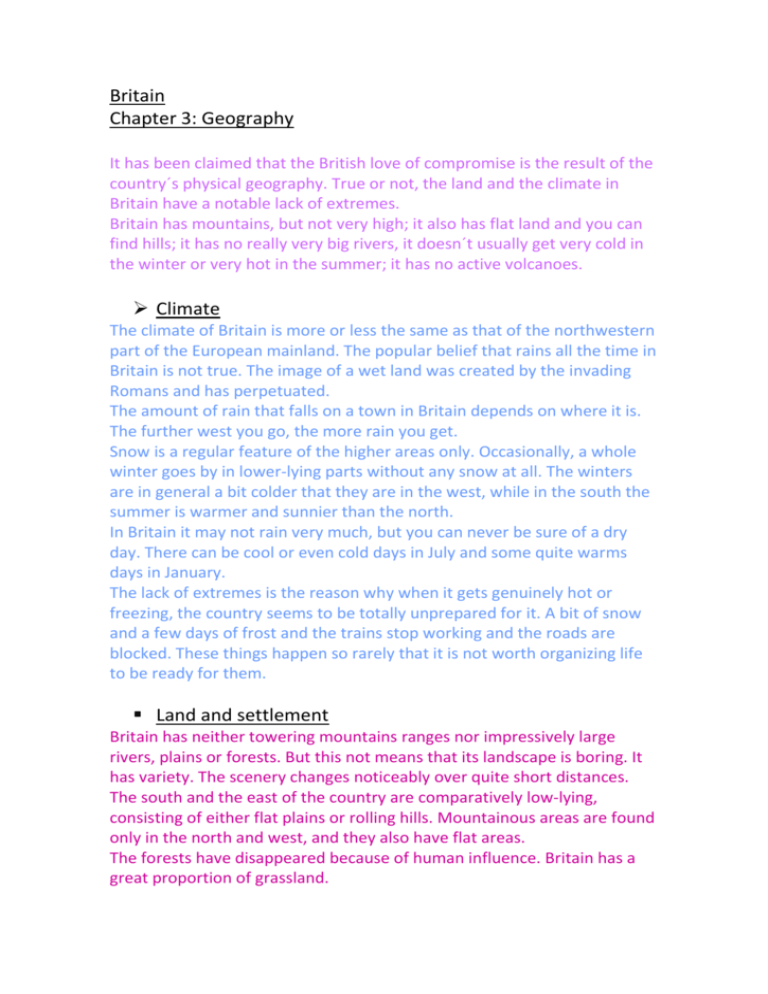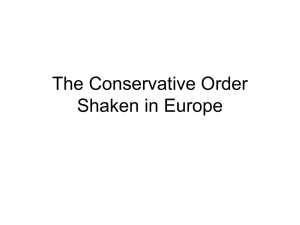Britain Chapter 3: Geography
advertisement

Britain Chapter 3: Geography It has been claimed that the British love of compromise is the result of the country´s physical geography. True or not, the land and the climate in Britain have a notable lack of extremes. Britain has mountains, but not very high; it also has flat land and you can find hills; it has no really very big rivers, it doesn´t usually get very cold in the winter or very hot in the summer; it has no active volcanoes. Climate The climate of Britain is more or less the same as that of the northwestern part of the European mainland. The popular belief that rains all the time in Britain is not true. The image of a wet land was created by the invading Romans and has perpetuated. The amount of rain that falls on a town in Britain depends on where it is. The further west you go, the more rain you get. Snow is a regular feature of the higher areas only. Occasionally, a whole winter goes by in lower-lying parts without any snow at all. The winters are in general a bit colder that they are in the west, while in the south the summer is warmer and sunnier than the north. In Britain it may not rain very much, but you can never be sure of a dry day. There can be cool or even cold days in July and some quite warms days in January. The lack of extremes is the reason why when it gets genuinely hot or freezing, the country seems to be totally unprepared for it. A bit of snow and a few days of frost and the trains stop working and the roads are blocked. These things happen so rarely that it is not worth organizing life to be ready for them. Land and settlement Britain has neither towering mountains ranges nor impressively large rivers, plains or forests. But this not means that its landscape is boring. It has variety. The scenery changes noticeably over quite short distances. The south and the east of the country are comparatively low-lying, consisting of either flat plains or rolling hills. Mountainous areas are found only in the north and west, and they also have flat areas. The forests have disappeared because of human influence. Britain has a great proportion of grassland. It is common in England the enclosure of fields with hedgerows. This increases the impression of variety. They support a great variety of birdlife. Much of the land is used for human habitation. In Britain, they don´t like living in blocks of flats in city centres. As a result, cities in Britain have been built outwards rather than upwards. However, because most people live in towns or cities rather than in villages or in the countryside, this habit of building outwards does not mean you see buildings wherever you go. There are areas of completely countryside everywhere and some of the mountainous areas remain virtually untouched. The environment and pollution It was in Britain that the word `smog’ was first used. As the world´s first industrialized country, its cities were the first to suffer this atmospheric condition. Water pollution was also a problem. Laws forbade the heating of homes with open coal fires in city areas and which stopped much of the pollution from factories. However, the great increase in the use of the motor car has caused an increase in a new kind of air pollution. This has caused poor air quality and it is bad enough for asthma suffers to do exercises outdoors. London London is the largest city in Europe and it dominates Britain. It is home for most of the government departments, it is the country business and banking centre, it is the centre of its transport networks and of all national newspapers. The original city of London was quite small. It did not contain Parliament or the Royal Court. Two areas well-known of London are the West End and the East End. The former is known for its many theatres, cinemas and expensive shops. The latter is known as the poorer residential area of central London. Large numbers of immigrants have settled here. There are many other parts of central London which have their own distinctive characters. The population in the central area has decreased. Most of the people live in London´s suburbs and they travel to the centre to work. London is a cosmopolitan city, because of its variety in culture and race. There are like 137 different languages spoken in the homes of just one district. In recent years it has been claimed that London is in decline. It is losing its place as one of the world´s biggest financial centres and it looks rather dirty and neglected. Nevertheless, its popularity as a tourist destination is still growing. It is also the favourite city to do business. Ω Southern England The area surrounding the outer suburbs of London has the reputation of being `commuter land’. It is the most densely populated area in the UK. We can find the county of Kent which is known as the garden of England, because of the many kinds of fruits and vegetables grown there. The Downs, a series of hills are used for sheep farming. The southern side of the Downs reaches the sea. Many retired people live along this coast. The region known as the `west country´ has an attractive image of rural beauty. There is some industry and one large city, but farming is more widespread than it is in most other regions. Some parts of the West Country are well-known for their dairy produce. The south-west peninsula with its rocky coast, numerous small bays and wild moorlands is the most popular holiday area in Britain. East Anglia, to the north-east of London, is also rural. There are large expanses of uniformly flat land. This with the dry climate has made it the main area for the growing of wheat and other arable crops. An area known as the Fens has been reclaimed form the sea. The Norfolk Broads is a popular area for boating holidays as it has no towns. The north-south divide There are many aspects of life in Britain which illustrate the so called north-south divide. Basically, the south has almost always been more prosperous than the north with lower rates of unemployment and more expensive houses. Northern England The Pennine Mountains run up the middle of northern England like a spine. On either side, the large deposits of coal and iron ore enabled these areas to lead the industrial revolution. On the western side, the Manchester area became the world´s leading producer of cotton goods; on the eastern side, towns such Bradford and Leeds became producers of woolen goods. Many other towns sprang up on both sides of the Pennines at this time as a result of the growth of auxiliary industries and of coal mining. In the minds of British people, the prototype of the noisy, dirty factory that symbolizes the industrial revolution is found in the industrial north. The achievements of these new industrial towns have induced a feeling of civic pride in their inhabitants. The decline of heavy industry in Europe has hit the industrial north of England hard. The towns on either side of the Pennines are unsuitable for agricultural purposes. The north of England is sparsely populated. The Lake District is where the romantic poets lived and wrote about its beauty. It is the favourite destination of people who enjoy walking holidays. It is classified as a National Park. Scotland Scotland has three regions. There are the Southern uplands, an area of small towns, quite far apart from each other, whose economy depends to a large extent on sheep farming. There is the plain and finally there are the highlands consisting of mountains and deep valleys and including numerous small islands off the west coast. This area of spectacular beauty occupies the same land area as the southern England but not many people live there. Tourism is important in the local economy, and so is the production of whisky. Most of the Scottish people live in the central plain and the east coast. Scotland´s two major cities have very different reputations. Glasgow is the third largest city in Britain. It is associated with heavy industry and some of the worst housing conditions in Britain. It also has a strong artistic heritage. It is considered the European city of culture. It is also reflected in it the divisions in the community, the Catholics and the protestants. Edinburgh has a middle-class image. It is the capital of Scotland and is associated with scholarship, the law and administration. This reputation together with its many fine historic buildings and also perhaps its topography has led top its being called `the Athens of the north’. Wales Most people in Wales live in one small part of it. It is the south-east of the country very populated. It is in south Wales where it is located the coal mine industry. Despite of its industry, no large cities have grown up in this area. It is the only part of Britain with a high proportion of industrial villages. Coal mining in south Wales has ceased and the transition to other forms of employment has been slow and painful. Most of the rest of Wales in mountainous. Communication between south and north is very difficult because of this. Northern Island The region is like the rest of Ireland, largely agricultural. It has several areas of spectacular natural beauty.









